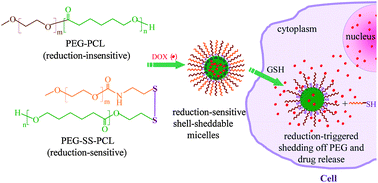The reduction-sensitive shedding of hydrophilic shells has recently emerged as a simple, effective and general approach to achieve markedly improved intracellular drug release from micelles. Here, the effects of disulfide content on reduction-sensitivity, triggered drug release and the anti-tumor activity of shell-sheddable micelles self-assembled from a mixture of reducible poly(ethylene glycol)–SS–poly(ε-caprolactone) (PEG–SS–PCL) and non-reducible poly(ethylene glycol)–poly(ε-caprolactone) (PEG–PCL) block copolymers were systematically investigated. Interestingly, in contrast to the rapid aggregation of PEG–SS–PCL micelles, mixed micelles containing 10–90 wt% PEG–PCL displayed little size change in response to 10 mM dithiothreitol (DTT). The in vitro release studies showed that under intracellular-mimicking reductive environments, the doxorubicin (DOX) release rate increased with increasing PEG–SS–PCL content in the micelles, in which about 29.4, 42.7, 77.9 and 86.9% DOX was released within 12 h from micelles containing 30, 50, 70 and 90 wt% PEG–SS–PCL, respectively. In contrast, DOX release was limited (<20%) under non-reductive physiological conditions. Notably, flow cytometry displayed clear correlation between cellular DOX levels and PEG–SS–PCL content in DOX-loaded micelles. Moreover, confocal laser scanning microscopy (CLSM) observations indicated progressively stronger DOX fluorescence in RAW 264.7 cells following 12 h treatment with DOX-loaded micelles containing increasing PEG–SS–PCL contents. In addition, MTT assays in RAW 264.7 cells showed that the cytotoxicity of DOX-loaded micelles was augmented proportionally to PEG–SS–PCL content, signifying the role of reduction-triggered “active” drug release in cells. These results have shown that the intracellular drug release and therefore anti-tumor activity of micellar drugs can be precisely controlled by the extent of reduction-triggered shedding of hydrophilic shells.


 Please wait while we load your content...
Please wait while we load your content...